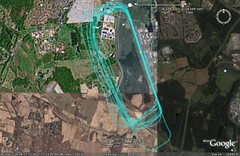i did pattern work at JYO (Leesburg) today. nothing special but i haven't done the pattern in a while and there was a little bit of wind. i did learn a few things though. i also have a garmin forerunner 305 gps heart rate monitor watch. i use it for running/biking and lately i've been taking it along on flights. afterwards, i can download the location points and import them into google earth and see a record of the flight. note the one extended downwind to base turn (the longer track at the bottom of the picture). the plane in the pattern ahead of me did an unusually long downwind leg and i had to extend my downwind to keep from "bumping" into him if i had turned base to final. he was a bit low and i was a bit high so i didn't see him at first. he was making radio calls but i thought the call i was hearing was the one i could see already over the threshold. it taught (hopefully permanently) to look down and ahead in addition to my level more carefully while in the pattern.
Saturday, September 29, 2007
Wednesday, September 26, 2007
the eclipse 500
i think i saw one of these at kjyo when i was last there: http://www.eclipseaviation.com/eclipse_500/
i was in a hurry and didn't write the tail number down.
i was in a hurry and didn't write the tail number down.
Tuesday, September 25, 2007
night cross country to KTHV (York, Pa) and night flying in general
I did a dual (ie with my instructor) cross country to KTHV (York, Pa) last night. We went via the FDK (Frederick) VOR (a radio navigational aid) and on the return used GPS to the STIL intersection (near Brunswick) and then ingress to JYO using the new(ish) ADIZ JYO notch 1227 transponder code. On egress I got flight following (asked ATC to keep an eye on us). The night sky was perfect, zero wind and absolutely calm with a bright moon. Flying at night is a much more pleasing experience. Other traffic is very visible and the air is very smooth. The THV beacon (the rotating light) was not working (which I could not find in the NOTAM list) which made it a bit harder to find. In fact, had my instructor not been there I would not have been able to find it. The runway lights are not PCL (pilot can turn them off/on via the radio) which adds to the difficulty. Since primary training can be done at night (except for engine out and some maneuvering) I may do a few more night flights (already have the minimum required for night landings).
Wednesday, September 12, 2007
i am determined to get better using the e-6b
i am determined to get better at using the e-6b so i ordered this:
http://learnthee6b.com/
for anyone that doesn't know what the e-6b is, it is a circular slide rule (that's been around for a long time) that is typically used for aviation related calculations. i seem to do well with it as long as i use it at least once every couple of days. it has a load of functions/capabilities that are surprisingly varied (and it doesn't need batteries).
http://learnthee6b.com/
for anyone that doesn't know what the e-6b is, it is a circular slide rule (that's been around for a long time) that is typically used for aviation related calculations. i seem to do well with it as long as i use it at least once every couple of days. it has a load of functions/capabilities that are surprisingly varied (and it doesn't need batteries).
Friday, September 7, 2007
pleasant surprise - linux and aopa flight planning
i had a pleasant surprise this morning, i've been meaning to try the aopa flight planner (http://www.aopa.org/flight_planner/) but it is a windows application and i (mostly) use linux. i decided to try it using the linux wine program (a windows emulator) and it appeared to work without any issues.
Thursday, September 6, 2007
ADIZ JYO Maneuver Area Seminar
Sat. 8-Sep-2007 at 1 and 3pm in the JYO Airport Conference Room.
Topics:
A) New ADIZ Dimensions.The new JYO Maneuvering Area.
B) How to file from and to JYO.
What “Gates” are and how to use them to file.
How to self announce (squawk and talk) on CTAF (122.975).
- using the new transponder codes 1226 and 1227 (you don’t talk to ATC anymore!)
When to squawk 1200 and when not to.
Making sure when inbound you change from 1200 to 1227.
Monitoring Guard Frequency 121.5 (if capable).
C) How to do Pattern Work at JYO
When to use the “Standard ADIZ” filing process (the old way).
D) What to do if your transponder fails.
E) The new “Kinder and Gentler” FAA Enforcement process
Topics:
A) New ADIZ Dimensions.The new JYO Maneuvering Area.
B) How to file from and to JYO.
What “Gates” are and how to use them to file.
How to self announce (squawk and talk) on CTAF (122.975).
- using the new transponder codes 1226 and 1227 (you don’t talk to ATC anymore!)
When to squawk 1200 and when not to.
Making sure when inbound you change from 1200 to 1227.
Monitoring Guard Frequency 121.5 (if capable).
C) How to do Pattern Work at JYO
When to use the “Standard ADIZ” filing process (the old way).
D) What to do if your transponder fails.
E) The new “Kinder and Gentler” FAA Enforcement process
Subscribe to:
Posts (Atom)
